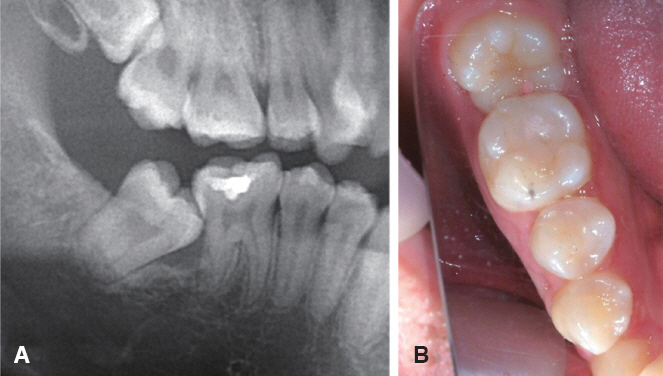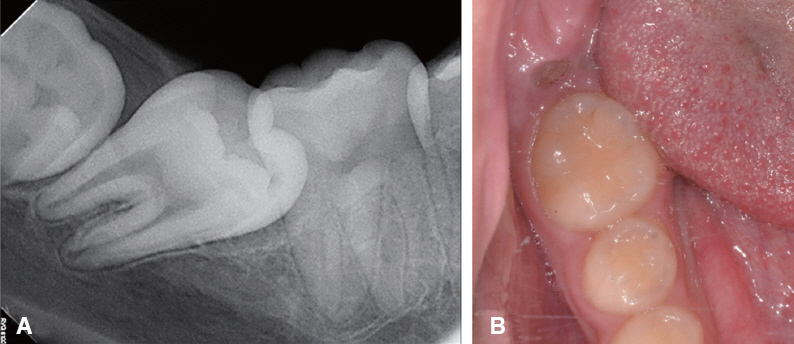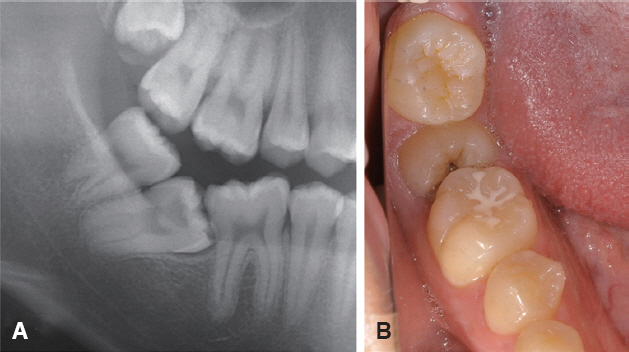J Dent Rehabil Appl Sci.
2017 Mar;33(1):25-33. 10.14368/jdras.2017.33.1.25.
Orthodontic upright treatment for mesioangular impacted lower second molar
- Affiliations
-
- 1Gajirunhan S Dental Clinic, Gimpo, Republic of Korea.
- 2Graduate School of Chosun University, Gwangju, Republic of Korea.
- 3Geoje Dental Clinic, Geoje, Republic of Korea.
- 4Department of Orthodontics, School of Dentistry, Chosun University, Gwangju, Republic of Korea. 022bracket@gmail.com
- KMID: 2377056
- DOI: http://doi.org/10.14368/jdras.2017.33.1.25
Abstract
- The lower 2(nd) molar eruption is beginning to mesiolingually, then rotate to distobuccally so it has a tendency to be tilted and impacted mesially. Signs and symptoms of impacted 2(nd) molar are similar to impacted 3(rd) molar's. However, treatment plan for impacted 2nd molar is different from that of impacted 3(rd)'s. The former is the preservation and uprighting of 2(nd) molar so that it could act to recovery of mastication, symmetrical facial growth, maintaining the symmetry of dental arch, stable occlusion, while the latter is the extraction of tooth. If the uprighting treatment is planned, most proper protocol of treatment and the additional treatment opition should be applied with consideration for it's crown exposure, present of 3(rd) molar which interrupt the uprighting process, extrusion of opposite tooth. Although it could not improve the esthetic result, it could prevent many dental problems. Therefore, uprighting for impacted lower 2(nd) molar is meaningful treatment.
Figure
Reference
-
References
1. Lee HL, Lee KH, La JY, An SY, Kim YH, Lim HS, Lee JW. Eruption guidance of impacted mandibular second molar. J Korean Acad Pediatr Dent. 2012; 39:404–11. DOI: 10.5933/JKAPD.2012.39.4.404.2. Andreasen JO, Peterson J, Laskin DM. Textbook and color atlas of tooth impactions. Copenhagen: Munksgaard;1997. p. 198–216.3. Grover PS, Lorton L. The incidence of unerupted permanent teeth and related clinical cases. Oral Surg Oral Med Oral Pathol. 1985; 59:420–5. DOI: 10.1016/0030-4220(85)90070-2.4. Bondemark L, Tsiopa J. Prevalence of ectopic eruption, impaction, retention and agenesis of the permanent second molar. Angle Orthod. 2007; 77:7738. DOI: 10.2319/072506-306.1. PMID: 17685771.5. Nanci A. Ten Cate’s oral histology: development, structure, and function. 7th ed. St. Louis: Elsevier Health Sciences;2007.6. Fu PS, Wang JC, Wu YM, Huang TK, Chen WC, Tseng YC, Tseng CH, Hung CC. Impacted mandibular second molars. Angle Orthod. 2012; 82:6705. DOI: 10.2319/102111-656.1. DOI: 10.2319/062411-409.1. PMID: 21988519.7. Raghoebar GM, Boering G, Vissink A, Stegenga B. Eruption disturbances of permanent molars: a review. J Oral Pathol Med. 1991; 20:159–66. DOI: 10.1111/j.1600-0714.1991.tb00913.x. PMID: 2061854.8. Sawicka M, Racka-Pilszak B, Rosnowska-Mazurkiewicz A. Uprighting partially impacted permanent second molars. Angle Orthod. 2007; 77:148–54. DOI: 10.2319/010206-461R.1. PMID: 17029525.9. Wellfelt B, Varpio M. Disturbed eruption of the permanent lower second molar: treatment and results. ASDC J Dent Child. 1988; 55:183–9. PMID: 3164337.10. Park HS, Kyung HM, Sung JH. A simple method of molar uprighting with micro-implant anchorage. J Clin Orthod. 2002; 36:592–6. PMID: 12428309.11. Babaji P, Singh V, Chaurasia VR, Jawale MR. Electro surgery in dentistry: report of cases. J Pediatr Dent. 2014; 2:20–4.12. Mavrogiannis M, Ellis J, Seymour RA, Thomason JM. The efficacy of three different surgical techniques in the management of drug induced gingival overgrowth. J Clin Periodontol. 2006; 33:677–82. DOI: 10.1111/j.1600-051X.2006.00968.x.
- Full Text Links
- Actions
-
Cited
- CITED
-
- Close
- Share
- Similar articles
-
- Orthodontic treatment of molar teeth impacted by local factors
- Orthodontic Traction of the Permanent Molar Using Skeletal Anchorage: A Case Report
- Straight lift technique as an alternative to surgical extraction of an intact, partially impacted mesioangular mandibular third molar
- Orthodontic Traction of the Impacted Mandibular Third Molars to Replace Severely Resorbed Mandibular Second Molars
- Surgical-orthodontic treatment of impacted teeth displaced by unicystic ameloblastoma









